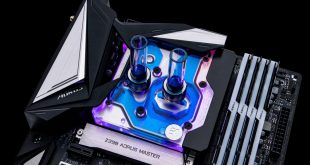As we mentioned in the operation principles of switching power supplies, the first thing it has to do in order to transform the utility grid AC voltage to DC is rectify the cleaned AC voltage to high voltage DC. This is done through a single chip, called the rectifying bridge, which is assisted by a number of large electrolytic capacitors (usually 1). It may or may not be connected to a heatsink, depending on the class and power output of the power supply.



The power factor correction (PFC) is also taking place at this part of the circuit. Switching power supplies are highly reactive power loads and will cause a huge current-voltage phase shift while operating, drawing a lot of useless reactive power along with the necessary active power. The PFC circuit controls the input current of the power supply and is trying to nullify the phase shift between the current and voltage.
A power supply without power factor correction usually has a power factor of 0.5, meaning that it may draw as much reactive power as active power altogether. An active PFC circuit will bring the power factor very close to 1, nullifying the reactive power draw almost completely.
The power factor will not increase the actual performance of the power supply itself directly, neither will decrease the consumption of power which home users pay for. Large businesses and industrial buildings are being billed for the amount of complex power they use, which includes the reactive power, and are fined by the utility company if the power factor is too low. Home users are being billed only for the amount of active power they use. But it is a huge mistake to believe that just because the home users are not getting billed for the amount reactive power they consume, there are no advantages at all.
The power factor is an efficiency figure, indicating how efficiently an electrical load can draw and make use of utility grid power. Despite that home users do not have to pay for the reactive power their equipment is drawing, their entire household electrical grid has to be sized according to the complex power they use. This includes wiring, safety equipment and UPS systems. In short, a power supply without a power factor correction circuit not only will strain the entire electrical grid (including that of the household) for no reason, but when purchasing an UPS a much larger and far more expensive product is necessary. (For more information, please read our “Why companies rate UPS in VAs and PSUs in Watts” article).
 KitGuru KitGuru.net – Tech News | Hardware News | Hardware Reviews | IOS | Mobile | Gaming | Graphics Cards
KitGuru KitGuru.net – Tech News | Hardware News | Hardware Reviews | IOS | Mobile | Gaming | Graphics Cards


